
(a)
Interpretation:
The product of the given reaction is to be predicted, considering one molar equivalent of
Concept introduction:
The C=C functional group of an alkene or the
Answer to Problem 19.54P
The product of the given reaction is
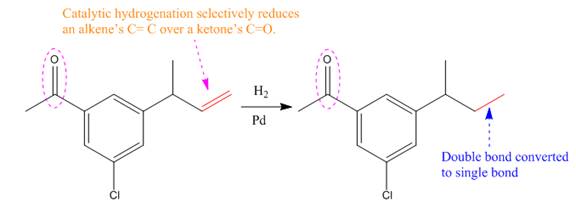
Explanation of Solution
The given reaction is
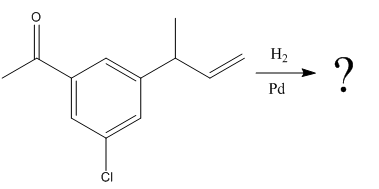
The given reaction condition correlates to catalytic hydrogenation; it reduces alkene’s C=C over ketone’s C=O. Thus, the
Therefore, the product of the given reaction is
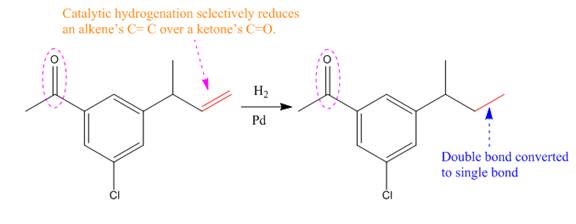
The product of the given reaction is predicted using the given reaction conditions.
(b)
Interpretation:
The product of the given reaction is to be predicted, considering one molar equivalent of
Concept introduction:
The C=C functional group of an alkene or the
Catalytic hydrogenation is more favored at a less sterically hindered multiple bond than at a more sterically hindered one.
Answer to Problem 19.54P
The product of the given reaction is
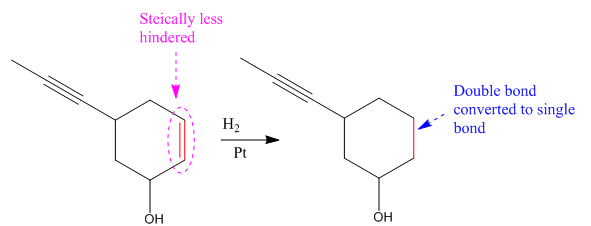
Explanation of Solution
The given reaction
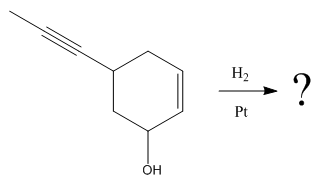
The given reaction condition correlates to catalytic hydrogenation. The substrate in the given reaction have two sites for catalytic hydrogenation, one C=C bond and another
Catalytic hydrogenation is more favored at a less sterically hindered multiple bond than at a more sterically hindered one.
In the given reaction, the C=C bond is sterically less hindered; therefore the

The product of the given reaction is predicted using given reaction conditions.
(c)
Interpretation:
The product of the given reaction is to be predicted, considering one molar equivalent of
Concept introduction:
The C=C functional group of an alkene or the
Answer to Problem 19.54P
The product of the given reaction is
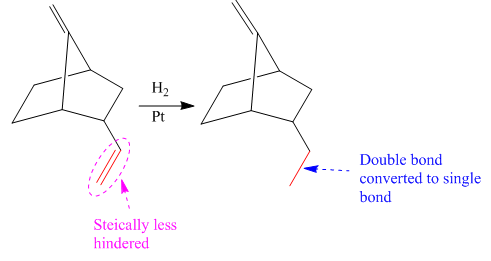
Explanation of Solution
The given reaction is
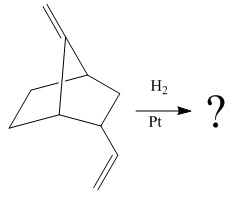
The given reaction condition correlates to catalytic hydrogenation. The substrate in the given reaction have two sites for catalytic hydrogenation, two C=C bonds.
Catalytic hydrogenation is more favored at a less sterically hindered multiple bond than at a more sterically hindered one.
In the given reaction, the C=C bond is at bottom is sterically less hindered; therefore the

The product of the given reaction is predicted using the given reaction conditions.
(d)
Interpretation:
The product of the given reaction is to be predicted, considering one molar equivalent of
Concept introduction:
The C=C functional group of an alkene or the
Answer to Problem 19.54P
The product of the given reaction is

Explanation of Solution
The given reaction is

The given reaction condition correlates to catalytic hydrogenation. The substrate in the given reaction has two sites for catalytic hydrogenation, one
The functional groups in alkenes, alkynes, and aldehydes can be selectively reduced over those in ketones, nitriles, and amides. Thus, the
Therefore, the product of the given reaction is

The product of the given reaction is predicted using the given reaction conditions.
(e)
Interpretation:
The product of the given reaction is to be predicted, considering one molar equivalent of
Concept introduction:
The C=C functional group of an alkene or the
Answer to Problem 19.54P
The product of the given reaction is

Explanation of Solution
The given reaction is

The given reaction condition correlates to catalytic hydrogenation. The substrate in the given reaction has two sites for catalytic hydrogenation, one C=C bond and another the nitrile group.
The functional group ketones can be selectively reduced over nitriles. Thus, the
Therefore, the product of the given reaction is

The product of the given reaction is predicted using the given reaction conditions.
(f)
Interpretation:
The product of the given reaction is to be predicted, considering one molar equivalent of
Concept introduction:
The C=C functional group of an alkene or the
Answer to Problem 19.54P
The product of the given reaction is
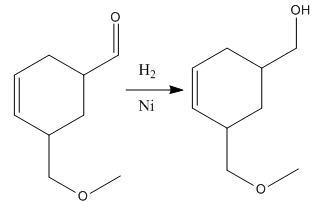
Explanation of Solution
The given reaction is
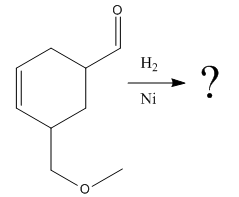
The given reaction condition correlates to catalytic hydrogenation. The substrate in the given reaction has two sites for catalytic hydrogenation, one C=C bond and another the aldehyde group.
Aldehydes and alkenes have similar reactivity toward catalytic hydrogenation, but the aldehyde group in the above substrate is less sterically hindered; thus
Therefore, the product of the given reaction is
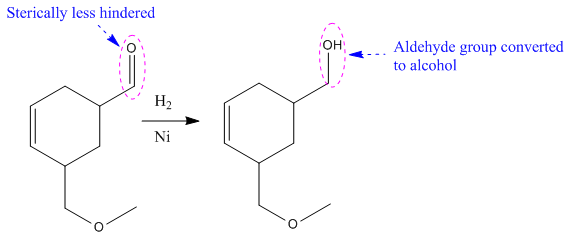
The product of the given reaction is predicted using the given reaction conditions.
(g)
Interpretation:
The product of the given reaction is to be predicted, considering one molar equivalent of
Concept introduction:
The C=C functional group of an alkene or the
Answer to Problem 19.54P
The product of the given reaction is

Explanation of Solution
The given reaction is

The given reaction condition correlates to catalytic hydrogenation. The substrate in the given reaction has two sites for catalytic hydrogenation, one
The functional groups in alkenes, alkynes, and aldehydes can be selectively reduced over those in ketones, nitriles, and amides. Thus, the
Therefore, the product of the given reaction is

The product of the given reaction is predicted using the given reaction conditions.
Want to see more full solutions like this?
Chapter 19 Solutions
Get Ready for Organic Chemistry
- Predict the product of this organic reaction: IZ + HO i P+H₂O Specifically, in the drawing area below draw the skeletal ("line") structure of P. If there is no reasonable possibility for P, check the No answer box under the drawing area. No Answer Click and drag to start drawing a structure. ☐ :arrow_forwardPredict the products of this organic reaction: 0 O ----- A + KOH ? CH3-CH2-C-O-CH2-C-CH3 Specifically, in the drawing area below draw the condensed structure of the product, or products, of this reaction. (If there's more than one product, draw them in any arrangement you like, so long as they aren't touching.) If there aren't any products because this reaction won't happen, check the No reaction box under the drawing area. No reaction Click anywhere to draw the first atom of your structure. X ⑤ èarrow_forwardPredict the products of this organic reaction: O CH3 + H2O + HCI A A? CH3-CH2-C-N-CH3 Specifically, in the drawing area below draw the condensed structure of the product, or products, of this reaction. If there's more than one product, draw them in any arrangement you like, so long as they aren't touching. If there aren't any products because this reaction won't happen, check the No reaction box under the drawing area. No Reaction Click anywhere to draw the first atom of your structure.arrow_forward
- What is the missing reactant in this organic reaction? R+ HO-C-CH2-CH3 0= CH3 CH3 —CH, C−NH—CH CH3 + H₂O Specifically, in the drawing area below draw the condensed structure of R. If there is more than one reasonable answer, you can draw any one of them. If there is no reasonable answer, check the No answer box under the drawing area. Note for advanced students: you may assume no products other than those shown above are formed. No Answer Click anywhere to draw the first atom of your structure. €arrow_forward个 CHEM&131 9267 - $25 - Intro to Mail - Hutchison, Allison (Student x Aktiv Learnin https://app.aktiv.com Draw the product of the reaction shown below. Ignore inorganic byproducts. + Na2Cr2O7 Acetone, H2SO4 Type here to search Dryng OH W Prarrow_forwardPredict the products of this organic reaction: OH + NaOH A? Specifically, in the drawing area below draw the skeletal ("line") structure of the product, or products, of this reaction. (If there's more than one product, draw them in any arrangement you like, so long as they aren't touching.) If there aren't any products because this reaction won't happen, check the No reaction box under the drawing area. No reaction Click and drag to start drawing a structure. ✓ Sarrow_forward
- Predict the products of this organic reaction: CH3-C-O-CH2-CH2-C-CH3 + H₂O ? A Specifically, in the drawing area below draw the condensed structure of the product, or products, of this reaction. (If there's more than one product, draw them in any arrangement you like, so long as they aren't touching.) If there aren't any products because this reaction won't happen, check the No reaction box under the drawing area. No reaction Click anywhere to draw the first atom of your structure. :☐ darrow_forwardDE d. Draw an arrow pushing mechanism for the following IN O CI N fo 人 P Polle DELL prt sc home end ins F5 F6 F7 F8 F9 F10 F11 F12arrow_forwardPredict the products of this organic reaction: + H₂O H* ? A Specifically, in the drawing area below draw the skeletal ("line") structure of the product, or products, of this reaction. (If there's more than one product, draw them in any arrangement you like, so long as they aren't touching.) If there aren't any products because this reaction won't happen, check the No reaction box under the drawing area. No Reaction Click and drag to start drawing a structure.arrow_forward
- Predict the major organic products of the reaction below and draw them on right side of the arrow. If there will be no significant reaction, check the box below the drawing area instead. C Cl CH, OH There will be no significant reaction. + pyridine G Click and drag to start drawing a structure.arrow_forwardWhat is the missing reactant in this organic reaction? H R+ H2O Δ OH 0= CH3-CH-O-CH3 + CH3-C-OH Specifically, in the drawing area below draw the condensed structure of R. If there is more than one reasonable answer, you can draw any one of them. If there is no reasonable answer, check the No answer box under the drawing area. No Answer Click anywhere to draw the first atom of your structure. dyarrow_forwardYou are trying to determine whether the following organic reaction can be done in a single synthesis step. If so, add any missing reagents or conditions in the drawing area below. If it isn't possible to do this reaction in a single synthesis step, check the box below the drawing area instead. Note for advanced students: if you have a choice of reagents to add, you should choose the least reactive and most economical reagents possible. Cl It isn't possible to do this reaction in a single synthesis step. + T OHarrow_forward
 ChemistryChemistryISBN:9781305957404Author:Steven S. Zumdahl, Susan A. Zumdahl, Donald J. DeCostePublisher:Cengage Learning
ChemistryChemistryISBN:9781305957404Author:Steven S. Zumdahl, Susan A. Zumdahl, Donald J. DeCostePublisher:Cengage Learning ChemistryChemistryISBN:9781259911156Author:Raymond Chang Dr., Jason Overby ProfessorPublisher:McGraw-Hill Education
ChemistryChemistryISBN:9781259911156Author:Raymond Chang Dr., Jason Overby ProfessorPublisher:McGraw-Hill Education Principles of Instrumental AnalysisChemistryISBN:9781305577213Author:Douglas A. Skoog, F. James Holler, Stanley R. CrouchPublisher:Cengage Learning
Principles of Instrumental AnalysisChemistryISBN:9781305577213Author:Douglas A. Skoog, F. James Holler, Stanley R. CrouchPublisher:Cengage Learning Organic ChemistryChemistryISBN:9780078021558Author:Janice Gorzynski Smith Dr.Publisher:McGraw-Hill Education
Organic ChemistryChemistryISBN:9780078021558Author:Janice Gorzynski Smith Dr.Publisher:McGraw-Hill Education Chemistry: Principles and ReactionsChemistryISBN:9781305079373Author:William L. Masterton, Cecile N. HurleyPublisher:Cengage Learning
Chemistry: Principles and ReactionsChemistryISBN:9781305079373Author:William L. Masterton, Cecile N. HurleyPublisher:Cengage Learning Elementary Principles of Chemical Processes, Bind...ChemistryISBN:9781118431221Author:Richard M. Felder, Ronald W. Rousseau, Lisa G. BullardPublisher:WILEY
Elementary Principles of Chemical Processes, Bind...ChemistryISBN:9781118431221Author:Richard M. Felder, Ronald W. Rousseau, Lisa G. BullardPublisher:WILEY





